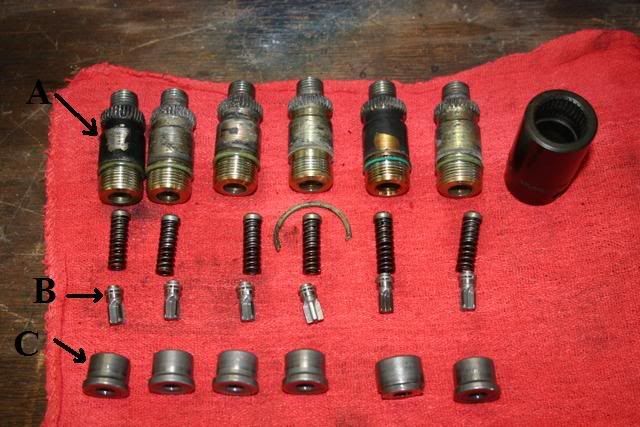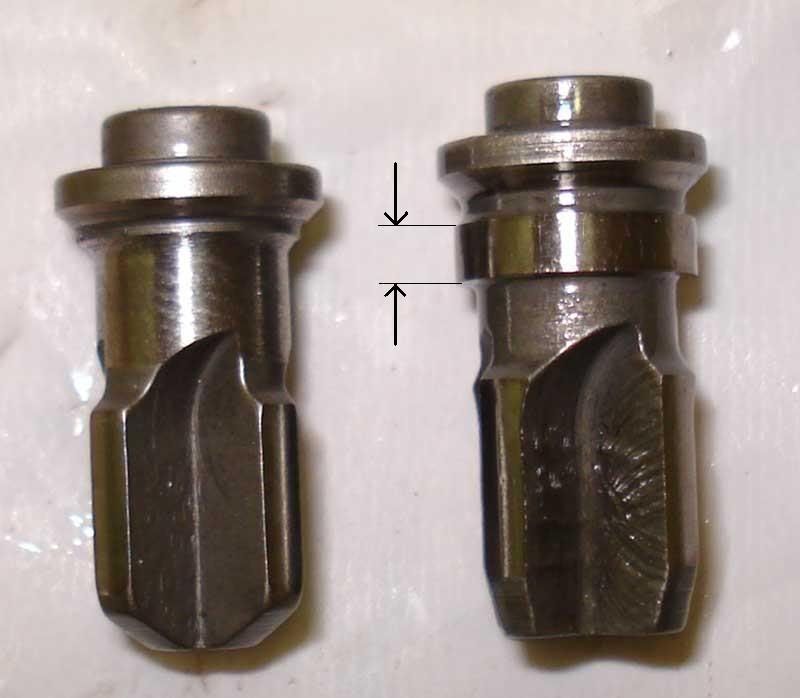So after making some phone calls and spending a lot of money on my own dime (not my shops) I decided to take it upon myself to do some testing with DV's on the same truck one after the other without adjusting the AFC or timing at all. I have no dyno figures but this is more about seat of the pants feel along with EGT, boost, smoke, and drivability. These aren't my direct results of testing but a general over view. Ill get to my results later...
131's Great Valve, Low EGT, slow throttle response but no change vs 181
181's Good Valve with large injectors, Great EGT control, slow throttle response on stock turbo/injectors
131/181 hybrids (my fav so far) the 131 valve has a .080" shoulder vs the 181's .085" so there is a touch longer duration of the injection event and about a 5cc change roughly. Nothing to go crazy about but 5-10hp over a 181 valve. The 181 seat design flows better threw the RPM band I believe do to the lack of void where the plunger meets the bottom of the seat. High end power is more noticed then low end making the 181 seat a good upgrade to any DV
191's .033 shoulder, an excellent hot street valve (people under rate them) High EGT unless timing is bumped, Instant throttle response and low spool time. Smoke is strong when you lay into the throttle but clears quickly with smaller turbos <66mm. Coupled with large injectors and large turbo it can really get you moving off the line with the added 50cc of fuel and wide spray duration spool time can be dropped 200rpm in some applications.
022's HOT very wide injection duration, I would only wanna use for competition and even then timing would have to be 22*+ to make me wanna use a .030 shoulder such as these. Spool is lighting fast and throttle response is to make for a fun experience specially coupled with large turbo and injectors with lots of timing and tuning.
to make for a fun experience specially coupled with large turbo and injectors with lots of timing and tuning.
024's A little cooler then a 191, this is more of a street valve that's been tamed a touch, throttle and spool times are equal to the 191 but a touch less heat. Differences are so little that I personally don't find the extra $ to be worth the gains (explain below)
Full Cut's COMPETITION ONLY type valve, depending on injector pop pressures these valves with no shoulder at all can give 2 injection events per plunger travel. The start and stop of the injection is messy and dirty, I would not want to run on any street vehicle at all. This would be ok for a sled puller that wants to stay on top of the turbo at all times, specially towards the end of the track when the truck hooks in high gear and the truck comes to a stop where boost drops as RPM falls due to load/traction. Not my fav though...In my experience no shoulder is no good..too messy of an injection cycle
052's A great tow DV, a touch of heat over a 131 but nothing to be concerned about, spool is 25% faster in comparison, clean, fast throttle response almost reminded me of the 191. A fun street truck that needs to work when duty calls would benefit from a set. This is another personal fav for a good balance of fuel/heat/smoke to do a little racing towing and so on. With injectors the DV really shines, WOT will rip hard on the top end but EGT still keeps in shape that I'm not staring at the EGT biting my nails. I would call this the workmans valve if I had to name it.
.042 I couldn't get ahold of sorry no testing
MY RESULTS BACK TO BACK
Bottom RPM <2200 and Top RPM >2200
181-stronger on top, weaker down low
131-stock
052-stronger threwout, good midrange, EGT and Smoke
024-getting warm, a strong low and mid range with a good top end
191-warm, the under dog. Very strong low and mid range with moderate top
022-HOT strong power across the board specially up top gains
Full Cuts-Smokey dumb to run on the street. I pegged a 1600* gauge before turbo pressure hit 30psi, spool was slow for messy and dirty injection, throttle response was good though, lopey engine idle, and lots of HAZE so competition is where this should stay.
This is a list from smallest to large as far as fueling. I don't have exact specs for each valve though sorry testing was rushed I wish I could have done a week with each to be through. Testing was limited to 2 hour rides in various conditions.
If I had to give awards it would be as follows and why
1ST-052 Best balance
2ND-131/181 Cool EGT low smoke
3RD-a tie 191 and 024. For the money spent a set of 191 would be fine on a play vehicle but don't expect to pull 20k daily and not hurt something...both valves are so close that it really comes to price.
4TH 022 and that would be race truck or puller, I wouldn't use on the street unless it was a dedicated play truck.
All this testing was on my personal truck on my dime. maxed 160 pump, stock injectors @280 bar, stock turbo @36psi on stock DV (varies with DV), 35psi fuel pressure, 4kgsk, 60lbsVS, basic exhaust and intake for flow, 18*, Smoke free tune (stock DV), NV4500, 3.54 gear on 33' tires. Those are the main points to effect results off the top of my head. No changes to settings made, conditions outside similar and same driving route of highway and city driving made, no towing.
131's Great Valve, Low EGT, slow throttle response but no change vs 181
181's Good Valve with large injectors, Great EGT control, slow throttle response on stock turbo/injectors
131/181 hybrids (my fav so far) the 131 valve has a .080" shoulder vs the 181's .085" so there is a touch longer duration of the injection event and about a 5cc change roughly. Nothing to go crazy about but 5-10hp over a 181 valve. The 181 seat design flows better threw the RPM band I believe do to the lack of void where the plunger meets the bottom of the seat. High end power is more noticed then low end making the 181 seat a good upgrade to any DV
191's .033 shoulder, an excellent hot street valve (people under rate them) High EGT unless timing is bumped, Instant throttle response and low spool time. Smoke is strong when you lay into the throttle but clears quickly with smaller turbos <66mm. Coupled with large injectors and large turbo it can really get you moving off the line with the added 50cc of fuel and wide spray duration spool time can be dropped 200rpm in some applications.
022's HOT very wide injection duration, I would only wanna use for competition and even then timing would have to be 22*+ to make me wanna use a .030 shoulder such as these. Spool is lighting fast and throttle response is
 to make for a fun experience specially coupled with large turbo and injectors with lots of timing and tuning.
to make for a fun experience specially coupled with large turbo and injectors with lots of timing and tuning.024's A little cooler then a 191, this is more of a street valve that's been tamed a touch, throttle and spool times are equal to the 191 but a touch less heat. Differences are so little that I personally don't find the extra $ to be worth the gains (explain below)
Full Cut's COMPETITION ONLY type valve, depending on injector pop pressures these valves with no shoulder at all can give 2 injection events per plunger travel. The start and stop of the injection is messy and dirty, I would not want to run on any street vehicle at all. This would be ok for a sled puller that wants to stay on top of the turbo at all times, specially towards the end of the track when the truck hooks in high gear and the truck comes to a stop where boost drops as RPM falls due to load/traction. Not my fav though...In my experience no shoulder is no good..too messy of an injection cycle
052's A great tow DV, a touch of heat over a 131 but nothing to be concerned about, spool is 25% faster in comparison, clean, fast throttle response almost reminded me of the 191. A fun street truck that needs to work when duty calls would benefit from a set. This is another personal fav for a good balance of fuel/heat/smoke to do a little racing towing and so on. With injectors the DV really shines, WOT will rip hard on the top end but EGT still keeps in shape that I'm not staring at the EGT biting my nails. I would call this the workmans valve if I had to name it.
.042 I couldn't get ahold of sorry no testing
MY RESULTS BACK TO BACK
Bottom RPM <2200 and Top RPM >2200
181-stronger on top, weaker down low
131-stock
052-stronger threwout, good midrange, EGT and Smoke
024-getting warm, a strong low and mid range with a good top end
191-warm, the under dog. Very strong low and mid range with moderate top
022-HOT strong power across the board specially up top gains
Full Cuts-Smokey dumb to run on the street. I pegged a 1600* gauge before turbo pressure hit 30psi, spool was slow for messy and dirty injection, throttle response was good though, lopey engine idle, and lots of HAZE so competition is where this should stay.
This is a list from smallest to large as far as fueling. I don't have exact specs for each valve though sorry testing was rushed I wish I could have done a week with each to be through. Testing was limited to 2 hour rides in various conditions.
If I had to give awards it would be as follows and why
1ST-052 Best balance
2ND-131/181 Cool EGT low smoke
3RD-a tie 191 and 024. For the money spent a set of 191 would be fine on a play vehicle but don't expect to pull 20k daily and not hurt something...both valves are so close that it really comes to price.
4TH 022 and that would be race truck or puller, I wouldn't use on the street unless it was a dedicated play truck.
All this testing was on my personal truck on my dime. maxed 160 pump, stock injectors @280 bar, stock turbo @36psi on stock DV (varies with DV), 35psi fuel pressure, 4kgsk, 60lbsVS, basic exhaust and intake for flow, 18*, Smoke free tune (stock DV), NV4500, 3.54 gear on 33' tires. Those are the main points to effect results off the top of my head. No changes to settings made, conditions outside similar and same driving route of highway and city driving made, no towing.





 please I bring this on and will admit to being stood corrected:S:
please I bring this on and will admit to being stood corrected:S:







